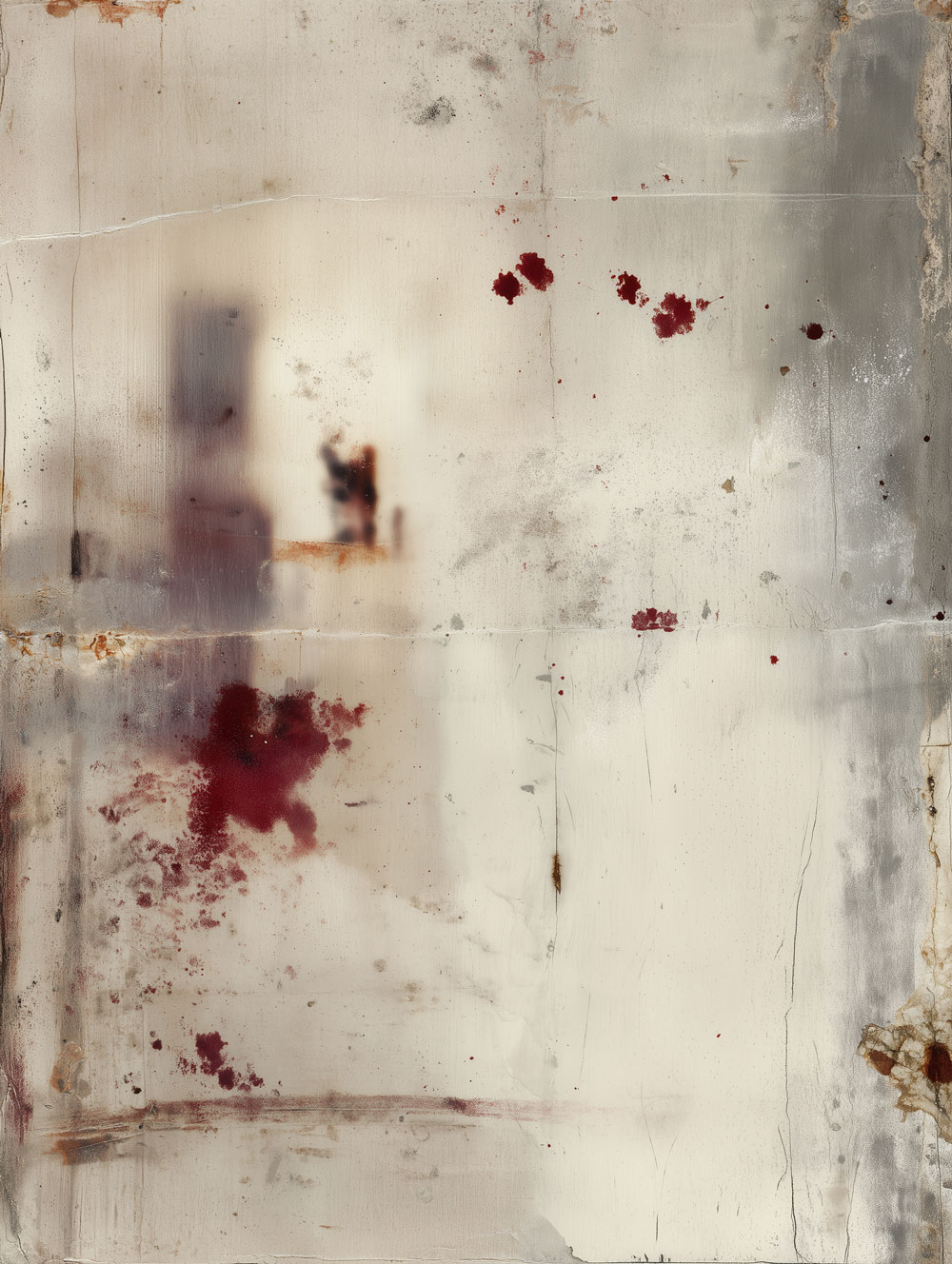Looking into the Face of the Gorgon
by Dana Amir and Azz a-Din

In August 2025, I joined a forum of Israeli mental health professionals called “Silence is a Crime.” The forum was designed to protest the Israeli mainstream media’s consistent silencing of the humanitarian situation in Gaza and demand that a voice be raised against the killing and starvation. In the first demonstration organized by the forum, a letter written by a Gazan doctor named Dr. Azz a-Din was read aloud. The letter, called “A Letter from Hell,” is presented here in English translation:
A Letter from Hell: Dr. Azz a-Din – Gaza – August 2025
I write these words not as a doctor, not as a son, nor as a man. I write as one who has descended into the depths of hell and returned—not with a prophecy—but with a silence in my throat and blood under my nails. What you are about to hear is not a message. It is a confession. A scream. A documentation of our fall. And may God forgive me—perhaps a final prayer.
We are trapped in a vortex. A great wheel of suffering that grinds us down, and this is no accident. This is the work of man. It is not fate that starves us, nor the heavens that bomb us; it is the logic of the powerful, the rituals of violence, the cold calculus of geopolitics, that have turned our streets into slaughterhouses.
Every morning, I wake up with the same thought: Has the battery died? Not mine; mine ran out long ago. But my phone’s. I need it to last long enough to charge it again at the hospital. To remain connected to something, anything that suggests we are still part of the world of the living. There is no water, no breakfast, no routine. There is only a salt-stained bucket, full of seawater, in the place where a sink once stood. I wash my face not to clean it but to remember that I am still flesh and blood, that I have not yet turned to dust. I do not eat. We eat once a day when we manage. We save the leftovers for a shared meal in the middle of the day: rice, lentils, silence. I arrive at the hospital and the doctor greets me with a list of shortages: there are no orthopedic implants, no promethazine, no certainty, no hope.
The floors are red, not as a metaphor, not as a political statement; they are red. And this is what I ask myself: Is our blood even red? Are we made of the same substance, the same suffering, the same divine breath that once stirred a man’s lungs? If so, why do we die like vermin, why does the world avert its eyes while we rot in plain sight? Why does the hunger of a single hostage shake the souls of nations, while the emaciated bodies of a million children elicit only polite disbelief?
I have lost 15 kilograms. My bones now have names. My cheeks are hollow caves. The children. God, the children are unrecognizable. They are no longer children. They are shadows with eyes. And still I said—release the hostages, all of them, without conditions. Because no one deserves to have their life traded like currency. But now I ask you, no, I demand an answer from you: Who will fight for us? Who will demand our release from this monstrous court that has condemned us to fire and famine? We did not choose this war; we did not ignite the flame. We are only the fuel, nothing more. We are the match that keeps the headlines burning. I tried to escape. I begged, bribed, cried like a child. But I failed. And now, all that is left is this. To stay alive one more day in a place designated to extinguish life itself.
You want to talk about casualty numbers? Here you go: This morning, twenty souls were crushed under the wheels of a relief truck. They ran to get food, fought robbers with empty hands, tore open sacks with their teeth, not for meat, for lentils, for rice, for the chance to breathe one more day. Sixty thousand dead, one hundred fifty thousand maimed, without limbs, without a future, most of them children. These children did nothing. Their only crime is that they were born in Gaza. Born on the wrong side of an imaginary line, a line drawn by men in suits, in air-conditioned rooms, with many maps. These children look exactly like the children of Be’eri. The same eyes, the same hands, the same feet. The same brilliant innocence that is hard to withstand. And yet, for one, there is mourning, and the other is erased. I ask you now, if your children were born here, would they still be alive? Would you still call it a war?
We are not numbers. We are not garbage. We are the mother who buries her son with her own hands. We are the father who gathers what is left of his family into a plastic bag. We are the little girl who continues to whisper a lullaby to her dead sister. This is not hell as theologians imagine it. This is not divine justice. This is not the lake of fire from the Book of Revelation. This is much worse. Because this hell is made by man. I swear to you, in God’s hell, no child suffers. In God’s hell, no one is tortured because of the geography of their birthplace. In God’s hell, justice still breathes somewhere beneath the ashes. But here, children die for sport, and the world calls it defense. And the world watches, and the world does nothing. Whether I write these words as a witness, as a prophet, as a man whose fate is sealed, as a doctor, as a ghost, I write these things because someone must. Because if we die without someone speaking, even God will not find our bones. From the Gaza Strip, from beneath the rubble, from beneath the sky, from beneath history, I still breathe. For now.
I never met Dr. Azz a-Din, nor have we ever corresponded directly. But his searing words shook me. In response to them, I wrote an essay that invites the Israeli reader to reflect on themselves through his words.
In his book Remnants of Auschwitz, the Italian philosopher Giorgio Agamben quotes Hermann Langbein, an Austrian historian and Auschwitz prisoner, who wrote (in the anthology Auschwitz: Testimonies and Reports, published in 1994): “For my part, I firmly decided that whatever happened, I would not commit suicide. I wanted to see everything, to live through everything, to experience everything, to preserve everything within me. To what end, since I would never have the possibility of shouting to the world what I knew? Simply because I did not want to remove myself from the way, I did not want to eliminate the witness I could become.”
Dr. Azz a-Din places himself in a similar position: he seeks to separate the witness of flesh and blood, who may not survive the next bombing, from the witness who observes things beyond the outlines of his private survival, not only “under the rubble” but also “beneath history”: the witness who insists on sketching the contours of the history that threatens to erase him.
In Latin, writes Agamben, there are two words that correspond to the meaning of the word “witness.” The first word is “testis,” which etymologically denotes one who places himself as a mediator, as a third party in a conflict between two sides. The second word is “superstes,” which means “one who has experienced something, who has gone through something to the very end, and can therefore provide testimony.”
Dr. Azz a-Din indeed positions himself in both these stances: the stance of one who has gone through, is going through, something to its end—and the stance of one who mediates, for his readers as well, between hell and language.
I read Dr. Azz a-Din’s painful words and recall a passage from a 2017 article by Pumla Gobodo-Madikizela, a psychoanalyst who has worked extensively on apartheid in South Africa and with the Truth and Reconciliation Commission established after its end, in which she writes: “The Zulu expression of greeting any time of the day is ‘sawubona’—I see you. And the Xhosa response to ‘How are you?’ is ‘ndikhona’—I am present. It is a language that acknowledges human reciprocity. An act of nonrecognition renders the other invisible; but it also erases the human subjectivity of the observer in the face of the other” (2017, p. 259).
Returning to Dr. Azz a-Din’s words—in the absence of human recognition, in the absence of the “I see you,” the mechanical battery of the mobile phone becomes the only evidence that he is indeed present. Technology tragically and artificially preserves the human connection that has been severed. Gaza has become an enclave of isolated hell, an “event without a witness,” in the words of the Israeli-American psychiatrist and psychoanalyst Dori Laub, an event where the refusal to call it by name collaborates with the question of whether it is happening at all.
One of the terms Primo Levi uses to define the Muselmann is “he who has seen the Gorgon.” In Greek mythology, the Gorgons are monstrous female figures with hair made of living snakes, known for their ability to turn those who look at them into stone. Since the sight of the Gorgon was meant to be lethal, Perseus had to sever her head without looking at her. “He who has seen the Gorgon,” in Levi’s conceptual world, is one who has seen what cannot be seen and is therefore trapped on the other side of the abyss, from which he can no longer return to the human community and human language. Dr. Azz a-Din’s words indeed refer to this meaning of the Gorgon’s face and to the immense, decisive weight of the repeated choice to turn one’s gaze away from hell, which is perceived as something that cannot be looked at while remaining alive.
We can think of this hell, our own creation, as the explicit embodiment of the attempt to annihilate what is perceived as the head of the Gorgon without looking at its face. However, what becomes increasingly apparent as this hell is revealed is that it is not possible to get rid of what we are unwilling to look at. On the contrary: what we are not willing to look at becomes, precisely through our refusal to look at it, a call that cannot be escaped. What we posit as the face of the Gorgon, the face of the other that we avoid recognizing, is increasingly revealed to us as our own face.
Muselmann was a term used among captives of Nazi concentration camps to refer to those of their fellow captives who, suffering from a combination of starvation (known also as “hunger disease”) and exhaustion, had become apathetically resigned to their impending death.
References
Gobodo-Madikizela, P. (2017). Response to Commentaries. J. Amer. Psychoanal. Assn., (65)(2):251-263.
- Dana Amir is a clinical psychologist, supervising and training analyst at the Israel Psychoanalytic Society, full professor and head of the interdisciplinary doctoral program in psychoanalysis at Haifa University, poetess, and literature researcher. She is the author of seven poetry books, four memoirs in prose, and five psychoanalytic nonfiction books. She has been awarded many literary as well as academic prizes, including six international psychoanalytic awards.
- Email: dana.amir2@gmail.com
- Dr. Azz a-Din is a doctor in Gaza.
ROOM is entirely dependent upon reader support. Please consider helping ROOM today with a tax-deductible donation. Any amount is deeply appreciated. |





